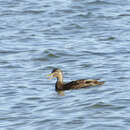More info for the terms:
cover,
hardwoodDuring the nesting season American black ducks use wooded areas more
than other dabbling ducks do. However, because they seem to use a wide
variety of habitats, it is difficult to determine specific requirements
on a broad scale [
13]. For brood rearing, American black ducks use
emergent wetlands, marshes, flooded hardwood areas, sloughs, creeks, or
ponds [
6]. During winter they usually gather on large bodies of water
or on coastlines where there is abundant plant food [
13].
American black ducks use coastal areas or ice-free areas on winter range
for feeding. They need protection from winter storms; this can be
provided by open water or high banks along open water or large
esturaries [
9]. A mix of marine and estuarine habitats offers the
greatest variety of food and cover, although specific data is
unavailable. For detailed information on habitat suitablity index
models for winter American black ducks refer to Lewis and Garrison [
9].
Others have detailed information on determining suitable nesting and
brood-rearing habitat [
6].

